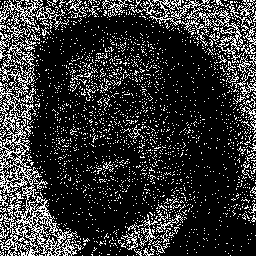


|
Typically, noise distorts
the signal. Surprisingly, stochastic resonance shows that in some nonlinear systems noise can improve the signal, instead of weakening and deteriorating it. Stochastic resonance has been observed in many physical systems, including the nervous system at the signal analysis level and the association of percepts. Noise is sometimes beneficial for living organisms.
Signals are usually measured with sensors, analyzed with a computer and stored on electronic devices. We can also think of the brain as a sophisticated measuring device that captures weak signals and brings out the information hidden in them.
Let's try to see it.
The Java applet allows you to play around with adding noise, both static and time-varying (unfortunately, it doesn't work in newer browsers). It adds noise to a black and white photo and then filters the signal using a threshold function to simulate poor visibility. Sometimes because we can see something better we have to squint our eyes, reducing retinal stimulation.



|
It's hard to see who these noisy images depict. Changing the intensity of the static noise doesn't help much.
What happens if we replace static noise with dynamic noise, as happens in real life? Every dozen or so milliseconds a new image will appear to which noise has been added -- black and white pixels in random places. Although images in the static frames are difficult to recognize, more details are seen in the dynamic image.

Dynamic noise - 20 frames/sec, noise at 120 - much better. |
Too much noise will, of course, make the whole image blurry, but the lack of additional time-varying noise also makes it impossible to see details. There is a certain optimal level of noise at which it manages to extract the most information from an image. Our brains pick up more information from videos than static images.
Adopted from Visual Stochastic Resonance, UMSL Center for Neurodynamics, paper by Enrico Simonotto, Massimo Riani, Charles Seife, Mark Roberts, Jennifer Twitty, and Frank Moss, Phys. Rev. Lett. 78, 1186 (1997)